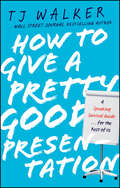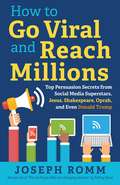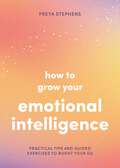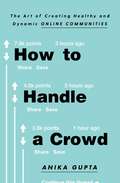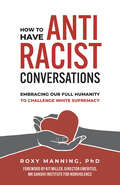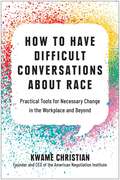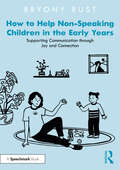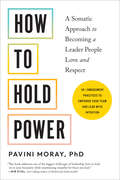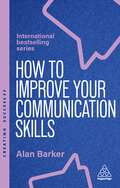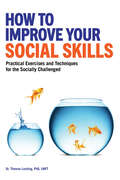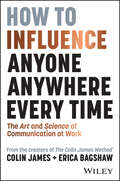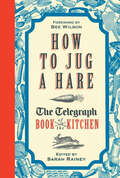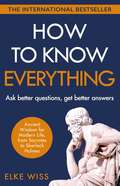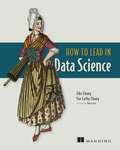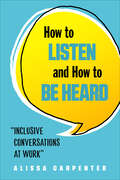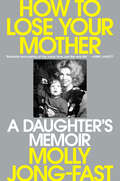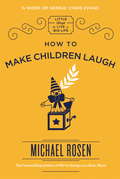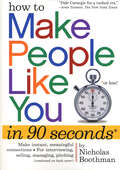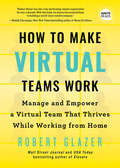- Table View
- List View
How to Give a Pretty Good Presentation
by T. J. WalkerReduce the time and stress associated with your presentationsBookshelves are crowded with books on how to be an exceptional presenter and promise to produce a brilliant, standing-ovation speaker. But what about a presentation resource for the rest of us? There are so many of us regular folk who who want to spend just a little time and effort to get over the big hurdle of giving a presentation, but don't know where to turn for advice.How to Give a Pretty Good Presentation is the easy answer to this common need. Straightforward, entertaining, and well-organized, this user-friendly resource will walk you step-by-step through the process from how to write, rehearse, and deliver a pretty good presentation that will make you appear confident, memorable, and competent. Although it does not promise the moon (or a standing ovation), this public speaking survival guide will help you:Appear confident (even while still feeling nervous!)Take the spotlight off of you and put it on your contentSave timeNot put people to sleep with your PowerPoint PresentationProduce better resultsMake better impressionsReduce the feelings of dread, sleeplessness, and procrastination associated with your presentationsPrepare even if you've waited until the day before or an hour before your presentation is to be givenWhatever your job, if you need to give a presentation and are feeling overwhelmed by it, How to Give a Pretty Good Presentation is there for you. If you want to reduce the time and stress associated with your presentations now and pass all future presentation opportunities with flying colors, then pick up this fun and accessible guide; you'll no doubt like the resulting improvement in both your personal and professional bottom line.
How to Go Viral and Reach Millions: Top Persuasion Secrets from Social Media Superstars, Jesus, Shakespeare, Oprah, and Even Donald Trump
by Joseph RommHow to Go Viral and Reach Millions is the first book to reveal all the latest secrets for consistently generating viral online content-words, images, or videos that are seen and shared by hundreds of thousands and eventually even millions of people, something Romm and his colleagues in three different organizations achieve routinely.
How to Go to Work: The Honest Advice No One Ever Tells You at the Start of Your Career
by Steven Haines Lucy ClaytonThe definitive careers guide for starting out in today's working worldIt's tougher than ever to get the fundamental skills you need to get started and thrive in your career.Whether you are on your first Saturday shift, about to start an apprenticeship or climbing the leadership ladder, this is your indispensable guide to surviving and thriving at work.Find out what really matters in getting hired for your first job and how to make the best start in your new role. Drawing on the collective wisdom of CEOs, creatives, scientists, activists and professionals in every industry, this is all you need to know about how to go to work.From dealing with your mistakes to celebrating your successes, from making an impression on day one to building your resilience and protecting your values, How to Go to Work is packed full of all the vital advice you need to jump-start your fledgling career. This vital practical guide will show you how to:- Find the right work experience and internships to get you through the door- Present your best self online and in person- Gain confidence, authority and resilience and thrive in your role- Navigate the ups and downs of starting your first or second job and help you make progress in your careerFrom office etiquette and how to make the most of any placement, to employment rights, how to deal with toxic workplaces, pensions and negotiating pay rises, How To Go To Work is the essential guide for anyone embarking upon or consolidating their career.
How to Grow Your Emotional Intelligence: Practical Tips and Guided Exercises to Boost Your EQ
by Summersdale PublishersLearn how to manage your emotions and improve your people skills with this book, which is bursting with advice on emotional intelligence and how to harness itHow to Grow Your Emotional Intelligence is a practical guide filled with tips to help you hone your skills in the four key areas of emotional intelligence.
How to Handle a Crowd: The Art of Creating Healthy and Dynamic Online Communities
by Anika GuptaA guide to successful community moderation exploring everything from the trenches of Reddit to your neighborhood Facebook page. Don&’t read the comments. Old advice, yet more relevant than ever. The tools we once hailed for their power to connect people and spark creativity can also be hotbeds of hate, harassment, and political division. Platforms like Facebook, YouTube, and Twitter are under fire for either too much or too little moderation. Creating and maintaining healthy online communities isn&’t easy. Over the course of two years of graduate research at MIT, former tech journalist and current product manager Anika Gupta interviewed moderators who&’d worked on the sidelines of gamer forums and in the quagmires of online news comments sections. She&’s spoken with professional and volunteer moderators for communities like Pantsuit Nation, Nextdoor, World of Warcraft guilds, Reddit, and FetLife. In How to Handle a Crowd, she shares what makes successful communities tick – and what you can learn from them about the delicate balance of community moderation. Topics include: -Building creative communities in online spaces -Bridging political division—and creating new alliances -Encouraging freedom of speech -Defining and eliminating hate and trolling -Ensuring safety for all participants- -Motivating community members to action How to Handle a Crowd is the perfect book for anyone looking to take their small community group to the next level, start a career in online moderation, or tackle their own business&’s comments section.
How to Have Antiracist Conversations: Embracing Our Full Humanity to Challenge White Supremacy
by Roxy ManningUtilizing Dr. Martin Luther King's Beloved Community framework, activists will be empowered to create change and equity through fierce yet compassionate dialogue against racism and systematic white supremacy.Can a person be both fierce and compassionate at once? Directly challenge racist speech or actions without seeking to humiliate the other person? Interrupt hateful or habitual forms of discrimination in new ways that foster deeper change? Dr. Roxy Manning believes it's possible—and you can learn how. In this book, Dr. Manning provides a new way to conceive of antiracist conversations, along with the practical tools and frameworks that make them possible. Her work is grounded in the idea of Beloved Community, as articulated by Dr. Martin Luther King, Jr., as a goal to aspire to and even experience now, in the present, when we refuse to give up on the possibility of human connection within ourselves, with potential allies, and with those whose words and actions create harm. This book fuels courage and provides tools to confront everyday forms of racism. It walks the reader through an effective, efficient model of dialogue that utilizes concepts of nonviolent communication and helps normalize talking about racism instead of treating it like a "third rail," strictly avoided or touched at one's peril.Readers will Be empowered to identify what kind of antiracist conversation they want to have-for example, do they only want to be heard, or do they want to negotiate a change in policy? Learn how to engage in antiracist conversations whether they are the Actor (person who says or does something racist), the Receiver (the target of racism), or the Bystander. Learn how to notice the underlying needs and values that motivate all human actions and how those values can open up pathways to transformation.Examples of antiracist conversations highlight different ways to initiate dialogue, raise awareness, speak one's truth, and make clear, doable requests or demands for change. Drawing on her experience as a clinical psychologist, a nonviolent communication practitioner, and an Afro-Caribbean immigrant, Dr. Manning provides a model of antiracist dialogue with practical applications for individuals and organizations.
How to Have Difficult Conversations About Race: Practical Tools for Necessary Change in the Workplace and Beyond
by Kwame ChristianIf we want a more equitable workplace—and a more equitable world—we have to talk to each other about race. But, for so many of us, that&’s easier said than done. When we avoid conversations about race, it&’s often because of fear: fear of discomfort, or of damaging important relationships; fear of being misunderstood, &“canceled,&” ostracized. Negotiation expert Kwame Christian&’s motto is: "The best things in life are on the other side of difficult conversations." How to Have Difficult Conversations About Race equips you with the skills you need to make these crucial conversations both easier and more productive. You&’ll not only gain the confidence to talk about race, but also learn how to actually make a difference when you do. Whether you&’re looking to create change for yourself and other BIPOC, or are a white ally seeking to support your coworkers or clients, you&’ll learn how to: Overcome your internal barriers to talking about diversity, equity, and inclusion (DEI). Work around others&’ barriers to productive discussion. Be strategic about the outcome you want and guide the conversation accordingly. Use &“Compassionate Curiosity&” to connect and persuade. Avoid common mistakes. Tackle some of the most common race-related conversations that come up in the workplace. If you&’ve ever struggled to turn your passion for change into persuasion or been too afraid to speak up at work (or outside of it), this book is for you. The first step toward lasting social change is productive discussion. With How to Have Difficult Conversations About Race, you&’ll never shy away from those crucial conversations again.
How to Have Impossible Conversations: A Very Practical Guide
by Peter Boghossian James Lindsay"This is a self-help book on how to argue effectively, conciliate, and gently persuade. The authors admit to getting it wrong in their own past conversations. One by one, I recognize the same mistakes in me. The world would be a better place if everyone read this book." -- Richard Dawkins, author of Science in the Soul and Outgrowing GodIn our current political climate, it seems impossible to have a reasonable conversation with anyone who has a different opinion. Whether you're online, in a classroom, an office, a town hall -- or just hoping to get through a family dinner with a stubborn relative -- dialogue shuts down when perspectives clash. Heated debates often lead to insults and shaming, blocking any possibility of productive discourse. Everyone seems to be on a hair trigger.In How to Have Impossible Conversations, Peter Boghossian and James Lindsay guide you through the straightforward, practical, conversational techniques necessary for every successful conversation -- whether the issue is climate change, religious faith, gender identity, race, poverty, immigration, or gun control. Boghossian and Lindsay teach the subtle art of instilling doubts and opening minds. They cover everything from learning the fundamentals for good conversations to achieving expert-level techniques to deal with hardliners and extremists. This book is the manual everyone needs to foster a climate of civility, connection, and empathy.
How to Help Non-Speaking Children in the Early Years: Supporting Communication through Joy and Connection
by Bryony RustIn every setting there are children who struggle to communicate. When they’re not talking, or only using a handful of words, it can be hard to know how to help. In this book, you’ll be encouraged to spot early moments of communication and respond with clarity. You’ll find an invitation to stop doing and start noticing, to try new things and collaborate with the team around you.The book presents key concepts in bite-size chunks, with a wealth of real-life examples from speech therapy sessions and early years settings. It explores practical strategies to help children develop their foundational speech, language and communication skills, and includes fresh ideas to:· Build honest and supportive conversations with parents about communication needs· Value empathy and imagination as we tune in to each child’s world· Take a pro-neurodiversity lens to inform your practice· Measure progress and support professional development.Communication is core to our sense of wellbeing, personal agency and belonging. With a focus on fostering joyful moments of connection, this book offers a fresh perspective and a dose of encouragement for all early years practitioners, speech and language therapists, SENCOs and key people looking to support positive communication development in the children in their care.
How to Hold Power: A Somatic Approach to Becoming a Leader People Love and Respect--30+ embodiment practices to empower your team and lead with intention
by Pavini MorayEssential skills for today's leaders: learn how to embody your ethics, earn your team's trust, and dismantle toxic work cultureLeaders and managers everywhere are learning the importance of creating safe, satisfying workplaces rooted in principles of social justice. But many of us who try to lead with ethics and integrity struggle with embracing a position of power and authority. You might worry about &“being bossy,&” unintentionally disrespecting others, or making the wrong call—and in the process, put your mind and body under so much stress that you burn out.Somatic educator and coach Pavini Moray argues that the secret to being an ethical, inspirational boss is rooted in our own bodies. In more than 30 simple exercises, reflections, and daily practices, you&’ll learn how to:Nurture trust with clients and coworkersGround and re-center when you&’re thrown off by a mistake or problemSoothe the &“Ouch!&” of negative feedbackBreak away from grind and hustle cultureTurn workplace conflict into a source of positive change and growthHelp your employees voice their own needs and feel heardUnderstand the nuances of consent beyond contract negotiationsGracefully acknowledge mistakesRepair relationships with employees, colleagues, and clientsDrawing from client case studies and their own experience as a manager, Moray teaches foundational embodiment practices—breath, grounding, observing, centering, and moving—through concrete examples that show how to use these skills in a variety of common workplace settings. By learning to practice embodied leadership presence, you can become a boss who truly listens to your employees; leads with inspiration; and brings your whole self to work every day.
How to Improve Your Communication Skills: How to Build Trust, Be Heard and Communicate With Confidence (Creating Success)
by Alan BarkerBetter communication skills will have a direct impact on your career development. Improve Your Communication Skills is your practical guide to effective communication in business.This fully updated 7th edition now features a handy self-assessment tool to help you profile your own preferred communication style, even more practical exercises, useful checklists and top tips, as well as content on influencing others and managing difficult conversations. This book provides vital guidance on improving your conversations, building rapport, giving effective presentations, writing excellent reports and networking successfully. With the help of Improve Your Communication Skills, you will be able to get your message across - every time.The Creating Success series of books...Unlock vital skills, power up your performance and get ahead with the bestselling Creating Success series. Written by experts for new and aspiring managers and leaders, this million-selling collection of accessible and empowering guides will get you up to speed in no time. Packed with clever thinking, smart advice and the kind of winning techniques that really get results, you'll make fast progress, quickly reach your goals and create lasting success in your career.
How to Improve Your Social Skills: Practical Exercises and Techniques for the Socially Challenged
by Thomas Lucking PhD, LMFTFrom socially challenged to socially skilled—practical techniques for building social skills Social skills help build relationships, create opportunities in the world, and improve your self-esteem and overall well-being. How to Improve Your Social Skills is filled with research-supported and evidence-based tools and techniques for building your social skills so you're able to approach any scenario with confidence. Whether you're shy, introverted, socially anxious, or have been diagnosed with a disorder that hinders your interactions with others, you'll discover helpful information about tuning into body language, getting comfortable with conversation, and employing different social skills. Discover ways to apply the skills you learn to real-life situations and relationships, like workplace interactions and friendships. How to Improve Your Social Skills includes: Social skill foundations—Learn about what social skills are, why they matter, how to set social goals, and much more. Evidence-based techniques—Explore tools that will help you overcome anxiety and fear, build confidence and self-awareness, and establish assertive and approachable body language. Situational strategies—Put practice to play in real-life scenarios, including dating, group and public settings, and beyond. Feel confident and empowered in any situation with these research-supported techniques and exercises for building social skills.
How to Influence Anyone, Anywhere, Every Time: The Art and Science of Communication at Work
by Colin James Erica BagshawWe communicate all the time. But do we have impact? Do we influence? When you speak, do people lean in? When they hear you, do others feel impressed, challenged, motivated or inspired? Through tested frameworks and instantly applicable techniques, How to Influence Anyone, Anywhere, Every Time shows you how to use your words and your body language to engage and persuade. With this handbook, you'll learn crucial communication skills for delivering with impact in any professional setting — be it in the boardroom, your next sales meeting or interpersonal interactions. Master how to deliver your message with conviction, confidence and clarity. Globally renowned speaking coaches Colin James and Erica Bagshaw share their proven methodology for wielding influence in any and every context. In How to Influence Anyone, Anywhere, Every Time, they show you how to systematically get and hold people’s attention — and use your influence to achieve positive results in your organisation or business. Whether you’re working face-to-face, you need to create presence online, or you’re crafting a written message, you’ll discover the tips you need. Communicate more effectively with a tried-and-trusted process for success, using the 3 Ds: Diagnose: Who is your audience, what is the context and what is your desired outcome? Design: Get the magic 12 steps that make it easy to tailor your next communication to better engage and influence your audience. Deliver: Don't know what to do with your hands? Learn how to master body language, your voice, visual aids and even your energy for a delivery that will captivate, inspire and persuade even the toughest audience. How to Influence Anyone, Anywhere, Every Time is a must-have resource for anyone who needs to present their ideas, gain trust and bring about real change.
How to Jug a Hare: The Telegraph Book of the Kitchen
by Sarah Rainey and Bee WilsonFeaturing a forward by a bestselling food writer from The Telegraph, this collection from the newspaper’s archives celebrates all things culinary.The opening of the Savoy in 1889, with Auguste Escoffier at the helm of its kitchen, rang in the new era of the celebrity chef. Though food is intrinsic to our very existence, the public’s interest was piqued and our pursuit of gastronomy has been on the rise ever since. Fortunately, The Telegraph has been there to document it.Trawling through the archives, features writer Sarah Rainey, has read through the great and the good as well as the more nostalgic recipes and culinary contemplations. Contributions from literary figures and their kitchens such as A.S. Byatt, sit beautifully alongside the slightly less erudite but equally wonderful entries that are a snapshot into the era they were written.The hidden gems of the past include interviews with “up-and-coming” chefs including Richard Stein, producing the best of New British Cooking in Padstow, not to mention the flamboyant Egon Ronay extolling the virtues of the “new” trend of coffee houses.Sometimes preventing hollandaise from splitting when you are sweating in a hot kitchen is just not worth it. So take some time out, sit down and read about what Mary Berry did before Great British Bake Off, how Heston Blumenthal wasn’t the first person to make weird flavours of ice cream and the trade tips from the perennially progressive Elizabeth David.With a foreword by food journalist and author Bee Wilson, this collection is the perfect gift for your favorite foodie or home chef.
How to Know Everything: Ask better questions, get better answers
by Elke WissThe international bestseller that will sharpen your mind, broaden your perspective and transform your relationships._____________________________________________________WHY ARE WE SO BAD AT ASKING GOOD QUESTIONS?In an increasingly polarized world, asking better questions in our daily and working lives is a radical shortcut to personal and professional success. It can create space for us to rethink our positions, find answers together, and even change our minds for the better.Drawing on the lessons of Socrates and other great thinkers, practical philosopher Elke Wiss lays out an essential toolkit to help you:· Transform debates into dialogues · Embrace your doubts like a true philosopher· Ditch your ego and become an active listener· Discover an open and curious Socratic attitude· Learn Sherlock Holmes's powers of observation · Open conversations up or dig down deeper with key question types· Explore thorny issues and avoid classic question pitfalls· Face your fear of asking and start connectingThe right questions can unlock the answers to anything - and help you know everything, without being a know-it-all. _____________________________WHAT READERS ARE SAYING:'Read this book, it will enrich your life!''A disarming and urgent book in today's world!''A great book for anyone who wants to better understand themselves and others!''Everyone should read this. What fascinating conversations we would have then!''A clear and practical book for brave thinkers who want to start having better, deeper conversations.''I found this book so valuable! A real enrichment to my daily life.' 'What a gem this book is!''Highly recommended for anyone who usually gets bogged down in discussions, quarrels, disagreements that lead to nothing.''A ray of hope in a time of dispute and polarization.' 'Elke Wiss makes practical philosophy manageable for everyone. A must read!''A cheerful, unconventional book.' 'An inspiring, easy-to-read book, full of practical exercises to get yourself started right away. For me it's a must read!''Its powerful message urges us to connect more with each other and with ourselves.''Some books can actually change your worldview or your daily actions, and as far as I'm concerned this is one of them. I recommend it to everyone.'
How to Land a Top-Paying Federal Job: Your Complete Guide to Opportunities, Internships, Resumes and Cover Letters, Networking, Interviews, Salaries, Promotions, and More!
by Lily WhitemanWritten by a successful career coach who herself has climbed the federal career ladder and served as a hiring manager, this indispensable book is the ultimate guide to securing a job in government work. How to Land a Top-Paying Federal Job steers federal applicants through every stage of their job search--from finding unadvertised openings and getting interviews to sealing enviable deals and even getting promoted. You&’ll gain insights from more than one hundred federal hiring managers, and learn the secrets to impressing these gatekeepers online, on paper, and in person.This updated second edition includes:more get-ahead tips,the latest hiring advice on writing winning applications,expanded directories for internships,listings of fast-track management training programs and fellowships,and information on emerging helpful websites and other resources.Complete with a companion CD filled with sample resumes, checklists, and templates, How to Land a Top-Paying Federal Job gives business professionals with big dreams of climbing the federal career ladder the inside scoop on landing some of the nation's most secure, well-paying, and rewarding jobs.
How to Lead in Data Science
by Jike Chong Yue Cathy ChangA field guide for the unique challenges of data science leadership, filled with transformative insights, personal experiences, and industry examples.In How To Lead in Data Science you will learn: Best practices for leading projects while balancing complex trade-offs Specifying, prioritizing, and planning projects from vague requirements Navigating structural challenges in your organization Working through project failures with positivity and tenacity Growing your team with coaching, mentoring, and advising Crafting technology roadmaps and championing successful projects Driving diversity, inclusion, and belonging within teams Architecting a long-term business strategy and data roadmap as an executive Delivering a data-driven culture and structuring productive data science organizations How to Lead in Data Science is full of techniques for leading data science at every seniority level—from heading up a single project to overseeing a whole company's data strategy. Authors Jike Chong and Yue Cathy Chang share hard-won advice that they've developed building data teams for LinkedIn, Acorns, Yiren Digital, large asset-management firms, Fortune 50 companies, and more. You'll find advice on plotting your long-term career advancement, as well as quick wins you can put into practice right away. Carefully crafted assessments and interview scenarios encourage introspection, reveal personal blind spots, and highlight development areas. About the technology Lead your data science teams and projects to success! To make a consistent, meaningful impact as a data science leader, you must articulate technology roadmaps, plan effective project strategies, support diversity, and create a positive environment for professional growth. This book delivers the wisdom and practical skills you need to thrive as a data science leader at all levels, from team member to the C-suite. About the book How to Lead in Data Science shares unique leadership techniques from high-performance data teams. It&’s filled with best practices for balancing project trade-offs and producing exceptional results, even when beginning with vague requirements or unclear expectations. You&’ll find a clearly presented modern leadership framework based on current case studies, with insights reaching all the way to Aristotle and Confucius. As you read, you&’ll build practical skills to grow and improve your team, your company&’s data culture, and yourself. What's inside How to coach and mentor team members Navigate an organization&’s structural challenges Secure commitments from other teams and partners Stay current with the technology landscape Advance your career About the reader For data science practitioners at all levels. About the author Dr. Jike Chong and Yue Cathy Chang build, lead, and grow high-performing data teams across industries in public and private companies, such as Acorns, LinkedIn, large asset-management firms, and Fortune 50 companies. Table of Contents 1 What makes a successful data scientist? PART 1 THE TECH LEAD: CULTIVATING LEADERSHIP 2 Capabilities for leading projects 3 Virtues for leading projects PART 2 THE MANAGER: NURTURING A TEAM 4 Capabilities for leading people 5 Virtues for leading people PART 3 THE DIRECTOR: GOVERNING A FUNCTION 6 Capabilities for leading a function 7 Virtues for leading a function PART 4 THE EXECUTIVE: INSPIRING AN INDUSTRY 8 Capabilities for leading a company 9 Virtues for leading a company PART 5 THE LOOP AND THE FUTURE 10 Landscape, organization, opportunity, and pr
How to Listen and How to Be Heard: Inclusive Conversations at Work
by Alissa CarpenterA straightforward guide to communicating more effectively on the job and building a more inclusive, creative, and productive workplace.How to Listen and How to Be Heard is a guide to empowering yourself and others to communicate with people who think, act, and experience things differently than you do. It’s also guide to communicating with more confidence, candor, and authenticity. Too often, people avoid difficult conversations, but these discussions often need to happen to bring people together so we can all succeed.There are so many different perspectives and experiences being brought to the table. And the best employees and leaders know that harnessing the power of these differences will build stronger teams, ideas, and organizations.How to Listen and How to be Heard shows you how to bridge the conversation gap and use your unique voice to start powerful conversations. Learn how to communicate with, through, and alongside what makes us different. We are all here to work together, so let’s get started.Praise for How to Listen and How to be HeardBest Nonfiction Book of 2020, Cosmopolitan“Gets to the heart of communication issues at work. Using Alissa Carpenters techniques, your workplace will be more inclusive, creative, and productive.” —Dorie Clark, executive education professor at the Duke University Fuqua School of Business, author of Reinventing You and Stand Out“The working world is a more diverse place than ever before. Open dialogues are a must and lead to innovation and harmonious teams. Alissa Carpenter provides a guide to successful communication in the workplace.” —Dan Schwabel, author of Back to Human, Promote Yourself, and Me 2.0“Carpenter offers useful insight on starting tough conversations. Many practical and actionable suggestions throughout the book make it a valuable read for anyone interested in working on their communication practices.” —Library Journal
How to Lose Your Mother: A Daughter's Memoir
by Molly Jong-Fast“With propulsive humor and perspective on her annus horribilis, Jong-Fast achieves the memoir’s transformative work of alchemy, arming us all with lines so good you won’t just want to underline them, you will want to cut them out to share.” —The Washington Post <br> “This raw, intimate memoir is a stunning portrait of difficult relationships and how we survive them.” —People <br> “Molly Jong-Fast’s memoir is mesmerizing, intimate, wise, unputdownable, crazily honest, heartbreaking, funny, illuminating—beautiful and painful at the same time, just like real life.” —Anne Lamott <P> From the political writer and podcaster, a ferociously honest and disarmingly funny memoir about her elusive mother’s encroaching dementia and a reckoning with her complicated childhood. Molly Jong-Fast is the only child of a famous woman, writer Erica Jong, whose sensational book Fear of Flying launched her into second-wave feminist stardom. She grew up yearning for a connection with her dreamy, glamorous, just out of reach mother, who always seemed to be heading somewhere that wasn’t with Molly. When, in 2023, Erica was diagnosed with dementia just as Molly’s husband discovered he had a rare cancer, Jong-Fast was catapulted into a transformative year. <P> How to Lose Your Mother is a compulsively readable memoir about an intense mother–daughter relationship, a sometimes chaotic upbringing with a fame-hungry parent, and the upheavals that challenge our hard-won adulthood. A pitch-perfect balance of acceptance and rage, humor and heart, How to Lose Your Mother tells a universal story of loss alongside a singular story of a literary life. This is a memoir that will stand alongside the classics of the genre. <b>New York Times Bestseller</b>
How to Make Children Laugh
by Michael Rosen'A WORK OF GENIUS' - Chris EvansJokes, a jack-in-the-box, jelly and jumping beans make children laugh.As do practical jokes, peekaboo, pantomine and poetry that makes no sense.Why and how does this work? And why does it matter?Writer and Professor of Children's Literature Michael Rosen, whose books - from We're Going on a Bear Hunt to Chocolate Cake - have made millions of children rock with laughter, gives us the tools for this greatest of gifts.
How to Make Children Laugh (Little Ways to Live a Big Life #1)
by Michael Rosen'A WORK OF GENIUS' - Chris EvansJokes, a jack-in-the-box, jelly and jumping beans make children laugh.As do practical jokes, peekaboo, pantomine and poetry that makes no sense.Why and how does this work? And why does it matter?Writer and Professor of Children's Literature Michael Rosen, whose books - from We're Going on a Bear Hunt to Chocolate Cake - have made millions of children rock with laughter, gives us the tools for this greatest of gifts.
How to Make People Like You in 90 Seconds or Less
by Nicholas BoothmanWhether selling, managing, negotiating, planning, collaborating, pitching, instructing-or on your knees with a marriage proposal-the secret of success is based on connecting with other people. Now that connection is infinitely easier to make through Nicholas Boothman's program of rapport by design.How to Make People Like You in 90 Seconds or Less is the work of a master of Neuro-Linguistic Programming whose career is teaching corporations and groups the secrets of successful face-to-face communication. Aimed at establishing rapport-that stage between meeting and communicating-How to Make People Like You focuses on the concept of synchrony. It shows how to synchronize attitude, synchronize body language, and synchronize voice tone so that you instantly and imperceptibly become someone the other person likes. Reinforcing these easy-to-learn skills is knowing how to read the other person's sensory preferences-most of us are visual, some are kinesthetic, and a minority are auditory. So when you say "I see what you mean" to a visual person, you're really speaking his language. Along the way the book covers attitude, nervousness, words that open a conversation and words that shut it down, compliments, eye cues, the magic of opposites attracting, and more. It's how to make the best of the most important 90 seconds in any relationship, business or personal.
How to Make Small Talk: Conversation Starters, Exercises, and Scenarios
by Melissa WadsworthLearn how to improve your basic conversation skills and engage in pleasant small talk for more positive face-to-face interactions in this simple, visually engaging guide.With today’s focus on technology and digital communication, face-to-face small talk is becoming increasingly difficult. How do you start a conversation with a stranger? What do you need to do to make a great first impression? What should you do when the conversation starts to drift off? In How to Make Small Talk, you’ll learn the art of small talk for all types of situations. With simple advice, engaging visuals, and brief exercises, this book makes it easy to improve your casual chitchat skills. From professional networking to first dates to casual run-ins with a neighbor, you’ll always be able to strike up a great conversation and leave a positive, lasting impression.
How to Make Someone Fall in Love With You in 90 Minutes or Less
by Nicholas BoothmanBuilding on the power of first impressions, Nicholas Boothman shows how to find and meet the love of your life—and have that person fall in love with you—in a mere 90 minutes, or approximately the time it takes to have a first dinner date. Now in paperback, this follow-up to his bestselling How to Make Someone Like You in 90 Seconds or Less is updated throughout with information on Internet dating, bringing together all of Mr. Boothman's considerable interpersonal skills to the problem of finding lasting love, fast. And it works: The feedback Boothman has received from a number of his clients begins, "Please come to my wedding. . . ." Starting with a series of revealing self-assessment tests that show how to find your Matched Opposite (a person who makes you feel complete), here is how to make a fabulous first impression, with tips on everything from attitude to accessories; how to be charming, not alarming; introductions, opening lines, and the 1-2-3 mantra of never hesitating. There are techniques for starting and maintaining conversation and for finding "Me Too" moments, plus the importance of flirting, incidental touching, rules of self-disclosure, and more. Real-life examples and analyses of actual conversations show the method at work.
How to Make Virtual Teams Work: Manage and Empower a Virtual Team That Thrives While Working from Home (Ignite Reads)
by Robert GlazerA remote book on building a successful virtual culture from USA TODAY and WALL STREET JOURNAL bestselling author, Robert Glazer!Close to twenty-five percent of professionals today work remotely in some capacity (and even more since the start of the pandemic). There are a lot of benefits to companies who employ a virtual workforce: cost savings on office space and other overhead, improved job performance, better employee morale, and a broader pool of talent from which to recruit. However, there are also challenges: communication limitations, social isolation, and managing distractions, among others.In his book, How to Make Virtual Teams Work, Robert Glazer taps into his decade of experience managing a virtual office—and winning twenty "best places to work" awards—while providing leaders with a step-by-step playbook on how to intentionally build a remote workforce and culture by developing core values that provide guidance in hiring talent who works well remotely, creating comprehensive onboarding plans, using technology to communicate and connect with remote employees, and more. This goes way beyond a typical HR strategy book. By employing these specific strategies, leaders can build a remote environment that thrives and make it one of their key competitive advantages.
